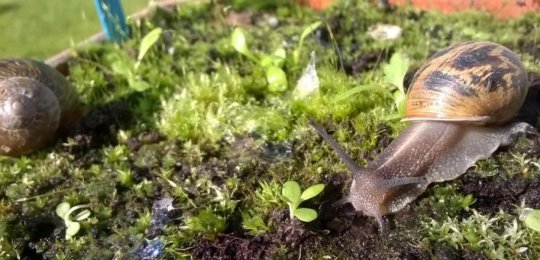[ad_1]
Gardeners have puzzled for years as to why some seedlings are more commonly eaten by slugs and snails — and new research suggests it may be down to the smells produced by young seedlings in the early stages of their development.
A study led by the University of Plymouth analysed the feeding preferences of hundreds of snails when presented with seedlings of 14 different grassland plant species.
Their work showed that snails were more likely to attack seedlings based on their preference for, or dislike of, naturally omitted volatile scents produced by the seedlings.
Scientists say the research, published in the journal Annals of Botany, provides us with a better understanding of the important role slugs and snails play in natural ecosystems.
The research was led by Dr Mick Hanley, Associate Professor (Reader) in Plant-Animal Interactions, and Post-Doctoral Fellow Roger Shannon at the University of Plymouth. It also involved academics from the University of Southampton and the University of Lyon, France.
Dr Hanley, the corresponding author for the research, said: “Slugs and snails are just as damaging to seedlings in natural habitats like grasslands as they are gardens. But we have known for many years that not all grassland species suffer the same likelihood of attack. This is important because variation in where and when terrestrial molluscs are active can have significant impacts on which species survive the vulnerable seedling stage. In effect, by removing some plant species as seedlings, slugs and snails help dictate the nature of the established vegetation.”
The research builds on a previous smaller study which focused specifically on oilseed rape, and suggested that harnessing naturally occurring chemicals could be used as a means to protect crop seedlings being eaten by common pests.
For the current study, scientists collected snails from the Plymouth and Southampton areas and presented them with a variety of grassland seedlings, with their choices being recorded.
Each of the seedling species was then characterised for the presence of common defensive compounds associated with taste, and volatile organic compounds (VOCs) associated with smell, to determine whether the snails’ choices were linked to either type of defence.
The results showed there was no relationship between the snails’ choices and the presence of chemicals like phenolics and cyanide — which occur naturally within some plant species — but that seedling acceptability was strongly related to VOCs.
The study was funded by the Leverhulme Trust, and Dr Hanley has recently received further funding from the trust to explore whether latitude and altitude make any difference to plant resistance
Dr Hanley added, “Charles Darwin recognised long ago the destructive impact that snails and slugs have on young seedlings. Yet since Darwin’s’ observations, biologists have never fully understood why these herbivores select particular plant species at their most vulnerable life history stage.
“We had believed for many years that molluscs chose seedlings based on their taste. But for a tiny seedling, even a single bite from a snail would probably be fatal. Our research suggests seedlings of some species use repellent volatile chemicals to prevent slug or snail damage before it occurs and so avoid any damage at all. This will give seedlings with this ability a tremendous advantage in terms of their recruitment probability at times when slugs or snails are abundant.”
Story Source:
Materials provided by University of Plymouth. Original written by Alan Williams. Note: Content may be edited for style and length.
[ad_2]















